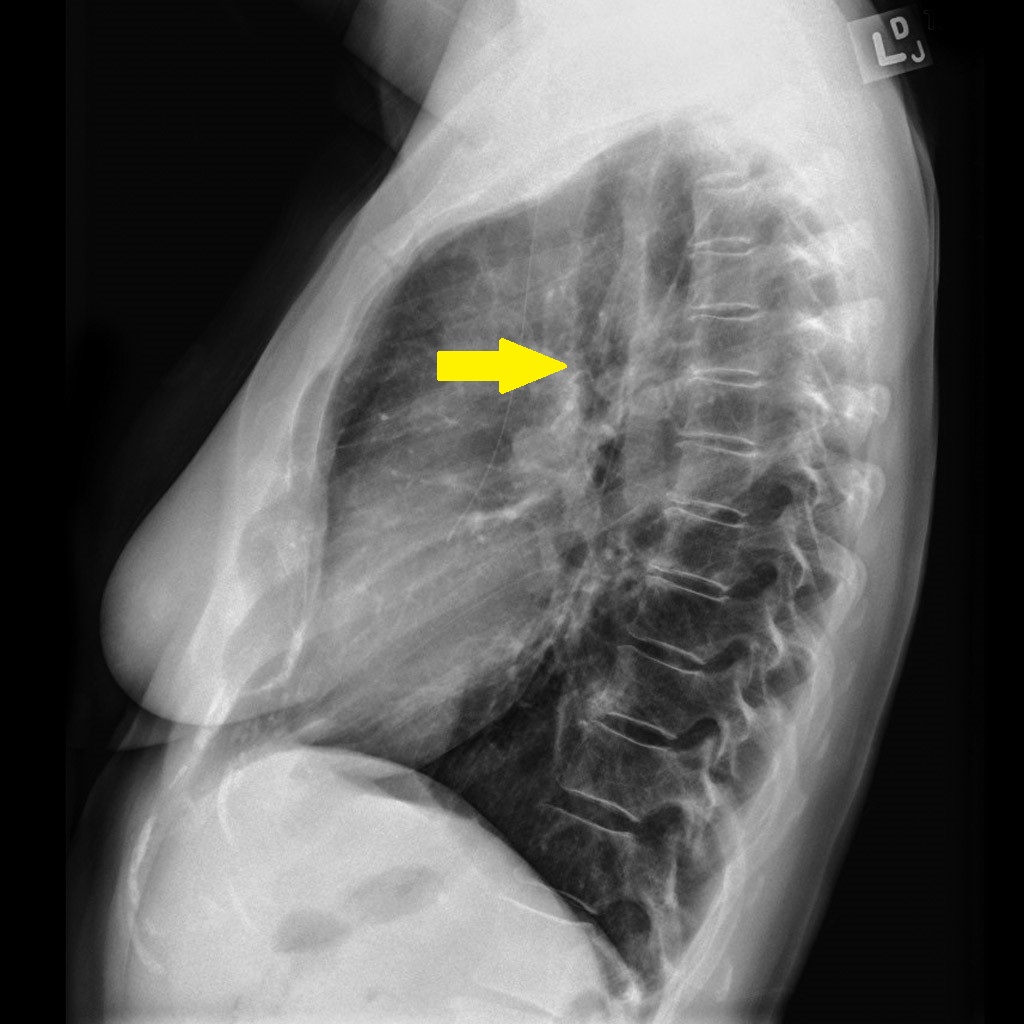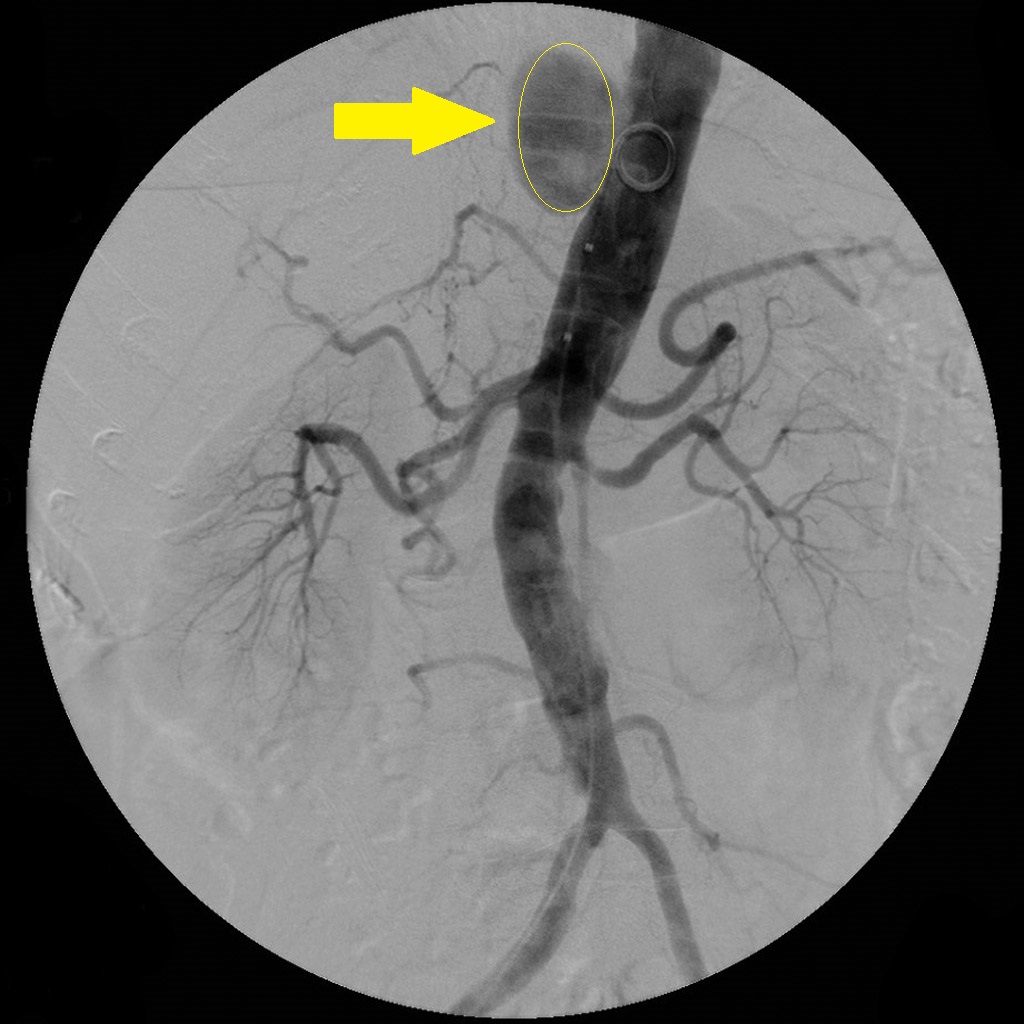Penetrating atherosclerotic aortic ulcer
Jump to navigation
Jump to search
![[1]](/images/0/08/Pathogenesis-of-penetrating-atherosclerotic-ulcer-illustration_%281%29.png)
Editor-In-Chief: C. Michael Gibson, M.S., M.D. [1];Associate Editor-In-Chief: Sahar Memar Montazerin, M.D.[2] Cafer Zorkun, M.D., Ph.D. [3]
Synonyms and keywords:: Penetrating aortic ulcer
Overview
Penetrating atherosclerotic aortic ulcer is ulceration of atheromatous plaque that has eroded the inner, elastic layer of the aortic wall, reached the medial layer, and produced a hematoma in the media.
Historical Perspective
- In 1934, Dr. Shennan was the first to describe the term "penetrating atherosclerotic aortic ulcer".[2]
- In 1986, Dr. Stanson further defined this disorder.[3]
Classification
- Penetrating atherosclerotic aortic ulcer is classified similarly to the aortic dissection.
- Learn more about the classification of aortic dissection by clicking here.
Pathophysiology
- The pathogenesis of penetrating atherosclerotic aortic ulcer involves severely diseased intima in the context of advanced atherosclerosis.[3]
- The thickened intima ulcerates and this ulceration propagates through intimal layer into media and sometimes it may pass media through the adventitial layer of the aorta and leads to the formation of a periaortic pseudoaneurysm and even transmural aortic rupture.
Causes
- Penetrating atherosclerotic aortic ulcer may be caused by advanced atherosclerotic disease.[3]
Differentiating Penetrating Atherosclerotic Aortic Ulcer from other Diseases
- Penetrating atherosclerotic aortic ulcer must be differentiated from other diseases that cause sudden sharp chest pain, dyspnea, and back pain. Such conditions can include aortic dissection, acute coronary syndrome, and intramural aortic hematoma.
- Other differential diagnoses of penetrating atherosclerotic aortic ulcer include inflammatory aortic aneurysm and conditions causing inflammatory aortitis such as Takayasu arteritis, giant cell arteritis, Behçet disease, Kawasaki disease, rheumatoid arthritis, sarcoidosis, Cogan syndrome, ankylosing spondylitis, systemic lupus erythematosus, and Wegener’s granulomatosis.[4]
- For more information on the differential diagnosis of penetrating atherosclerotic aortic ulcer, click here.
Epidemiology and Demographics
- The exact prevalence of penetrating atherosclerotic aortic ulcer is unknown.
- The incidence of penetrating atherosclerotic aortic ulcer is 1.62 per 100,000 individuals worldwide.[5]
- Unlike typical aortic dissection, penetrating atherosclerotic aortic ulcers most often occur in elderly patients with severe underlying atherosclerosis.[4]
- It usually affects people in their seventh decade of life or when older. [3]
- Penetrating atherosclerotic aortic ulcer affects men at a greater extent than women.
Risk Factors
- Common risk factors in the development of penetrating atherosclerotic aortic ulcer include old age, having a smoking history, male gender, hypertension, coronary artery disease, and hyperlipidemia.[3][4][6][7]
- Other less common risk factors include bicuspid aortic valve, prior aortic dilatation, connective tissue disorder, and prior aortic surgery.[5]
Screening
- There is insufficient evidence to recommend routine screening for penetrating atherosclerotic aortic ulcer.
Natural History, Complications, and Prognosis
- The natural history of penetrating atherosclerotic aortic ulcer include an elderly with multiple risk factors for advanced atherosclerosis who presents with acute onset chest pain and dyspnea which may progress and lead to aortic dissection.[8]
- Penetrating atherosclerotic aortic ulcer starts with the progressive increase in aortic size with subsequent aneurysm formation.[7][9]
- If left untreated, patients with penetrating atherosclerotic aortic ulcer may progress to develop an intramural hematoma, pseudoaneurysm, acute aortic dissection, or even aortic rupture.
- Prognosis is generally poor and even worse than that of aortic dissection.
Diagnosis
Diagnostic Study of Choice
- Contrast-enhanced CT imaging is the diagnostic study of choice for diagnosis of penetrating atherosclerotic aortic ulcer.
- Table below provides a comparison of diagnostic imaging studies for the diagnosis of penetrating atherosclerotic aortic ulcer:[10]
| Diagnostic Modality | Diagnostic Value |
|---|---|
| |
| |
| |
|
History and Symptoms
- History and symptoms of pentrating atherosclerotic aortic ulcer may greatly overlap with those of aortic dissection. Nevertheless, lesion is usually localized and does not result in radiating pain. Patients may also remain asymptomatic. The most common symptoms include chest pain and back pain.[11]
Physical Examination
- Physical examination of patients with penetrating atherosclerotic aortic ulcer may overlap with that of aortic dissection. Nevertheless, due to the localized nature of the lesion, signs, such as absent pulse or diastolic murmur of aortic regurgitation are unlikely. Possible physical examination findings include hypotension and shock especially in the case of accompanying aortic rupture.[11]
Laboratory Findings
- There are no diagnostic laboratory findings associated with penetrating atherosclerotic aortic ulcer.
Electrocardiogram
- There are no ECG findings associated with penetrating atherosclerotic aortic ulcer.
 |
X-ray
- Findings associated with penetrating atherosclerotic aortic ulcer on an x-ray may include the widening of the thoracoabdominal aortic silhouette, diffuse or focal enlargement of thoracic descending aorta, pleural effusion, and deviated trachea.[13]
- A normal chest x-ray does not rule out the diagnosis of penetrating atherosclerotic aortic ulcer.[14]
Echocardigraphy
- Tans-esophageal echocardiography has been approved to be sensitive and specific for the diagnosis of aortic diseases.[15]
CT Scan
- CT scan imaging with intravenous contrast is the diagnostic study of choice for diagnosis of penetrating atherosclerotic aortic ulcer.[7]
- Findings suggestive of penetrating atherosclerotic aortic ulcer include a localized ulcer passing from intima into aortic wall or contrast leak through a calcified plaque.
- It usually affects mid to distal third of descending aorta.
- Ulcer is usually defined by focal thickening or enhancement of the aortic wall.
 |
MRI
- MRI study is superior to conventional CT scan in the diagnosis of penetrating atherosclerotic aortic ulcer.[17]
- Finding suggestive of the diagnosis includes a well-defined ulcer with flow void phenomenon on T1 images.
Other Imaging Findings
- Findings associated with penetrating atherosclerotic aortic ulcer on a CT angiography may include the presence of false aneurysm.
Other Diagnostic Studies
- There are no other diagnostic studies associated with penetrating atherosclerotic aortic ulcer.
Treatment
 |
Medical Therapy
- The treatment aims at preventing the penetrating atherosclerotic aortic ulcer to progress into aortic dissection. Indications for treatment interventions include recurrent and refractory pain, signs of contained rupture, rapidly growing aortic ulcer, and presence of periaortic hematoma or pleural effusion.[19][20]
- Early interventions are indicated in ulcer with a diameter greater than 20 mm.
Surgery
- Surgical interventions may be indicated in penetrating atherosclerotic aortic ulcer depending on the anatomic location of the ulcer, clinical presentation and comorbidities. However, since most of the patients are poor surgical candidates due to advanced age and associated comorbidities, thoracic endovascular aortic repair (TEVAR) is used more frequently.[20][21]
Primary Prevention
- There are no established measures for the primary prevention of penetrating atherosclerotic aortic ulcer.
Secondary Prevention
- There are no established measures for the secondary prevention of penetrating atherosclerotic aortic ulcer.
Guidelines
2014 ESC Guidelines on the Diagnosis and Treatment of Aortic Diseases (DO NOT EDIT)[10]
| Recommendations | Class | Level |
|---|---|---|
|
I | C |
|
IIa | C |
|
I | C |
| I | C | |
|
IIa | C |
|
IIb | C |
Abbreviations: CT: computed tomography; MRI: magnetic resonance imaging; PAU: penetrating aortic ulcer; TEVAR: thoracic endovascular aortic repair.
See Also
External Links
References
- ↑ Case courtesy of Dr Vincent Tatco, Radiopaedia.org, rID: 48455
- ↑ Peery, Thomas M. (1936). "Dissecting aneurysms of the aorta". American Heart Journal. 12 (6): 650–665. doi:10.1016/S0002-8703(36)91001-3. ISSN 0002-8703.
- ↑ Jump up to: 3.0 3.1 3.2 3.3 3.4 Stanson, Anthony W.; Kazmier, Francis J.; Hollier, Larry H.; Edwards, William D.; Pairolero, Peter C.; Sheedy, Patrick F.; Joyce, John W.; Johnson, Michaël C. (1986). "Penetrating atherosclerotic ulcers of the thoracic aorta: natural history and clinicopathologic correlations". Annals of Vascular Surgery. 1 (1): 15–23. doi:10.1016/S0890-5096(06)60697-3. ISSN 0890-5096.
- ↑ Jump up to: 4.0 4.1 4.2 Kotsis, Thomas; Spyropoulos, Basileios Georgiou; Asaloumidis, Nikolaos; Christoforou, Panagitsa; Katseni, Konstantina; Papaconstantinou, Ioannis (2019). "Penetrating Atherosclerotic Ulcers of the Abdominal Aorta: A Case Report and Review of the Literature". Vascular Specialist International. 35 (3): 152–159. doi:10.5758/vsi.2019.35.3.152. ISSN 2288-7970.
- ↑ Jump up to: 5.0 5.1 DeMartino, Randall R.; Sen, Indrani; Huang, Ying; Bower, Thomas C.; Oderich, Gustavo S.; Pochettino, Alberto; Greason, Kevin; Kalra, Manju; Johnstone, Jill; Shuja, Fahad; Harmsen, W. Scott; Macedo, Thanila; Mandrekar, Jay; Chamberlain, Alanna M.; Weiss, Salome; Goodney, Philip P.; Roger, Veronique (2018). "Population-Based Assessment of the Incidence of Aortic Dissection, Intramural Hematoma, and Penetrating Ulcer, and Its Associated Mortality From 1995 to 2015". Circulation: Cardiovascular Quality and Outcomes. 11 (8). doi:10.1161/CIRCOUTCOMES.118.004689. ISSN 1941-7713.
- ↑ Coady, Michael A.; Rizzo, John A.; Elefteriades, John A. (1999). "PATHOLOGIC VARIANTS OF THORACIC AORTIC DISSECTIONS". Cardiology Clinics. 17 (4): 637–657. doi:10.1016/S0733-8651(05)70106-5. ISSN 0733-8651.
- ↑ Jump up to: 7.0 7.1 7.2 Hayashi, Hideyuki; Matsuoka, Yohjiro; Sakamoto, Ichiro; Sueyoshi, Eijun; Okimoto, Tomoaki; Hayashi, Kuniaki; Matsunaga, Naofumi (2000). "Penetrating Atherosclerotic Ulcer of the Aorta: Imaging Features and Disease Concept". RadioGraphics. 20 (4): 995–1005. doi:10.1148/radiographics.20.4.g00jl01995. ISSN 0271-5333.
- ↑ Ueda, Takuya; Chin, Anne; Petrovitch, Ivan; Fleischmann, Dominik (2012). "A pictorial review of acute aortic syndrome: discriminating and overlapping features as revealed by ECG-gated multidetector-row CT angiography". Insights into Imaging. 3 (6): 561–571. doi:10.1007/s13244-012-0195-7. ISSN 1869-4101.
- ↑ Nathan, Derek P.; Boonn, William; Lai, Eric; Wang, Grace J.; Desai, Nimesh; Woo, Edward Y.; Fairman, Ronald M.; Jackson, Benjamin M. (2012). "Presentation, complications, and natural history of penetrating atherosclerotic ulcer disease". Journal of Vascular Surgery. 55 (1): 10–15. doi:10.1016/j.jvs.2011.08.005. ISSN 0741-5214.
- ↑ Jump up to: 10.0 10.1 Erbel R, Aboyans V, Boileau C, Bossone E, Bartolomeo RD, Eggebrecht H, Evangelista A, Falk V, Frank H, Gaemperli O, Grabenwöger M, Haverich A, Iung B, Manolis AJ, Meijboom F, Nienaber CA, Roffi M, Rousseau H, Sechtem U, Sirnes PA, Allmen RS, Vrints CJ (November 2014). "2014 ESC Guidelines on the diagnosis and treatment of aortic diseases: Document covering acute and chronic aortic diseases of the thoracic and abdominal aorta of the adult. The Task Force for the Diagnosis and Treatment of Aortic Diseases of the European Society of Cardiology (ESC)". Eur. Heart J. 35 (41): 2873–926. doi:10.1093/eurheartj/ehu281. PMID 25173340.
- ↑ Jump up to: 11.0 11.1 Bossone, Eduardo; LaBounty, Troy M; Eagle, Kim A (2018). "Acute aortic syndromes: diagnosis and management, an update". European Heart Journal. 39 (9): 739–749d. doi:10.1093/eurheartj/ehx319. ISSN 0195-668X.
- ↑ Case courtesy of A.Prof Frank Gaillard, Radiopaedia.org, rID: 10163
- ↑ Eggebrecht, Holger; Baumgart, Dietrich; Schmermund, Axel; Herold, Ulf; Hunold, Peter; Jakob, Heinz; Erbel, Raimund (2003). "Penetrating atherosclerotic ulcer of the aorta: treatment by endovascular stent-graft placement". Current Opinion in Cardiology. 18 (6): 431–435. doi:10.1097/00001573-200311000-00002. ISSN 0268-4705.
- ↑ Kyaw, Htoo; Sadiq, Sanah; Chowdhury, Arnab; Gholamrezaee, Rashin; Yoe, Linus (2016). "An uncommon cause of chest pain – penetrating atherosclerotic aortic ulcer". Journal of Community Hospital Internal Medicine Perspectives. 6 (3): 31506. doi:10.3402/jchimp.v6.31506. ISSN 2000-9666.
- ↑ Sommer T, Fehske W, Holzknecht N, Smekal AV, Keller E, Lutterbey G, Kreft B, Kuhl C, Gieseke J, Abu-Ramadan D, Schild H (May 1996). "Aortic dissection: a comparative study of diagnosis with spiral CT, multiplanar transesophageal echocardiography, and MR imaging". Radiology. 199 (2): 347–52. doi:10.1148/radiology.199.2.8668776. PMID 8668776.
- ↑ Case courtesy of A.Prof Frank Gaillard, Radiopaedia.org, rID: 10163
- ↑ Harris, James A.; Bis, Kostaki G.; Glover, John L.; Bendick, Phillip J.; Shetty, Anil; Brown, O.William (1994). "Penetrating atherosclerotic ulcers of the aorta". Journal of Vascular Surgery. 19 (1): 90–99. doi:10.1016/S0741-5214(94)70124-5. ISSN 0741-5214.
- ↑ Case courtesy of A.Prof Frank Gaillard, Radiopaedia.org, rID: 10163
- ↑ Ganaha, Fumikiyo; Miller, D. Craig; Sugimoto, Koji; Do, Young Soo; Minamiguchi, Hiroki; Saito, Haruo; Mitchell, R. Scott; Dake, Michael D. (2002). "Prognosis of Aortic Intramural Hematoma With and Without Penetrating Atherosclerotic Ulcer". Circulation. 106 (3): 342–348. doi:10.1161/01.CIR.0000022164.26075.5A. ISSN 0009-7322.
- ↑ Jump up to: 20.0 20.1 Eggebrecht, Holger; Herold, Ulf; Schmermund, Axel; Lind, Alexander Y.; Kuhnt, Oliver; Martini, Stefan; Kühl, Hilmar; Kienbaum, Peter; Peters, Jürgen; Jakob, Heinz; Erbel, Raimund; Baumgart, Dietrich (2006). "Endovascular stent-graft treatment of penetrating aortic ulcer". American Heart Journal. 151 (2): 530–536. doi:10.1016/j.ahj.2005.05.020. ISSN 0002-8703.
- ↑ Demers, Philippe; Miller, D.Craig; Mitchell, R.Scott; Kee, Stephen T; Chagonjian, Lynn; Dake, Michael D (2004). "Stent-graft repair of penetrating atherosclerotic ulcers in the descending thoracic aorta: mid-term results". The Annals of Thoracic Surgery. 77 (1): 81–86. doi:10.1016/S0003-4975(03)00816-6. ISSN 0003-4975.